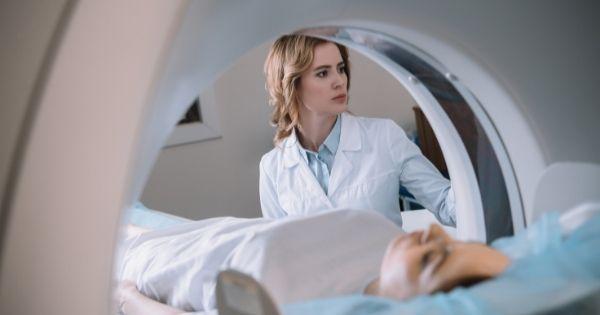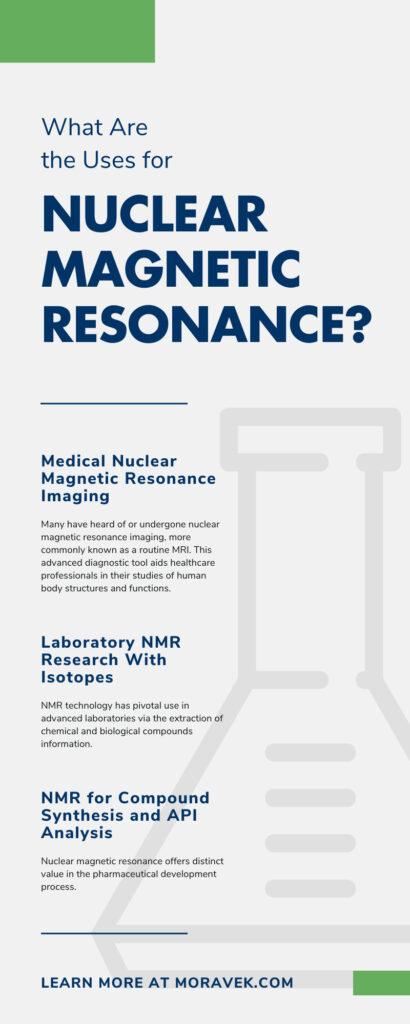
Nuclear magnetic resonance (NMR) is a specialized form of spectroscopy with far-extending applications in an array of physical sciences. Spectroscopy involves the study of the absorption and release of light and other radioactive properties by matter. Spectroscopic techniques are applicable in essentially every technical sector of the primary sciences—all the while, nuclear magnetic resonance analysis has a particularly significant role in the field of chemistry.
What are the uses for nuclear magnetic resonance? Using modern instrumentation, NMR structural studies provide a wide variety of applications in the modern medical field. Let’s take an in-depth look at the powerful development of this technique, the fundamental concepts of its revolutionary technology, and the core usages available for researchers in the industry today.
The Power of NMR Spectroscopy
Organic chemistry can use a multitude of techniques to purify or analyze molecules. Despite the abundance of processes usable, none are similar in scope or scale to the complete efficiency of nuclear magnetic resonance. As a key quantitative or qualitative analytical tool, NMR is a technique that critically determines the molecular identity, content, structure, and behavior of chemical compounds and composites.
With a dedicated small sample, NMR can powerfully provide detailed critical information regarding specific molecules and the very nature of their chemical bonds. Scientists can use NMR phenomena to examine chemical, physical, and biological matter properties in mere minutes. How is NMR so straightforwardly powerful and successful? The reason behind its preeminence as a research tool of choice is its non-destructive analytical sensitivity, first uncovered by physicists in the 1940s.
The Beginning Developments of NMR
In the 1920s and 30s, scientists discovered that varying nuclear particles—and nuclei themselves—could not only spin but also have magnetic movements. However, measuring these nuclear magnetic properties proved difficult due to the perpetual effects of electrons. Compared to electrons, the magnetic moments of nuclei are minuscule, meaning the type of electromagnetic radiation necessary for nuclear magnetic response is vastly diverse from that of an electron magnetic response.
Physicists hoped to use the measurement of nuclear magnetic moments to gain a closer insight into atomic nuclear structure. This deep interest generated further research and experimentation on the subject. In 1945, Felix Bloch of Stanford University and Edward Mills Purcell of Harvard University initially detected NMR signals in different forms of condensed matter. The physicist duo would later co-receive a Nobel Prize award for their contribution to the development of the analytical NMR technique.
The first spectrometers were created for commercial use in the 1950s and became primary probing tools for scientific researchers. Chemists in specialization studies have utilized NMR methods ever since.
The Fundamental Concepts of NMR
Why and how does this NMR analysis work? The fundamental concept behind nuclear magnetic resonance is the probe of an atom’s chemical environment. The atom is universally known as the essential building block of all matter, consisting of electron, proton, and neutron particles.
NMR techniques focus on the nature of the atom’s nuclei, the spinning of the nuclei, and the magnetic properties of the nuclei. Each nucleus has its own distinctive magnetic field.
As follows, nuclear magnetic resonance is a phenomenon that occurs when certain nuclei in atoms in a static magnetic field face charges from a strong oscillating electromagnetic field. Using radio frequency (RF) radiation via low-energy photons, the nuclei absorb a higher energy level that manipulates their spins. The atomic nuclei resonate in response to determine a full NMR spectrum for observation.
A Chemical Shift: A Beneficial Boon for Chemists
As mentioned above, critical information about a nucleus’ chemical environment is accessible through its resonant signal frequency. Scientists can see the smallest details and observe behavior in all matter with the extensive utility of NMR technology.
For chemists, the ability to measure the chemical shift resulting from varied molecular electron distribution makes the technique most paramount. During synthesis, chemists can perform non-destructive chemical analysis on samples to identify the detailed 3D structure of molecules and their movements.
The Main Usages of Nuclear Magnetic Resonance
What are the uses for nuclear magnetic resonance in chemistry for all intents and purposes? Present-day NMR applications are widespread across the board, yet usages have proven most beneficial in the general medical field and in pharmaceutical studies. Certain aspects are still under their own research and development to gain a greater understanding.
Medical Nuclear Magnetic Resonance Imaging
Many have heard of or undergone nuclear magnetic resonance imaging, more commonly known as a routine MRI. This advanced diagnostic tool aids healthcare professionals in their studies of human body structures and functions.
The electromagnetic spectra results allow physicians to observe areas customarily unseen, including internal neurological, musculoskeletal, cardiovascular, and oncological systems.As an investigative tool, this type of imaging can deliver precise results with minimal risks or harmful effects to patients.
Laboratory NMR Research With Isotopes
NMR technology has pivotal use in advanced laboratories via the extraction of chemical and biological compounds information. The process involves the usage of varying isotopes with a nonzero nuclear spin or an odd number of neutrons and protons.
1H and 13C are the most common isotopes utilized to detect NMR signals, but others include 3He, 15N, 2H, or 19F isotopes. Each isotope resonates at varied frequencies to help understand molecular basics for use in specific applications, including metabolic-targeted medical care and treatment.
NMR for Compound Synthesis and API Analysis
Nuclear magnetic resonance offers distinct value in the pharmaceutical development process. Thorough valuation and analysis are key to developing pharmaceutical products that are safe and efficient for clinical use. NMR technology assists with facets of quantitative analysis during compound synthesis to investigate, clarify, and confirm correct compound structures.
Chemists can observe the purity profiles, characteristics, and compositions of the ingredients in drug products to ensure the highest quality and efficiency standards. Contract manufacturers can then produce radiolabeled compounds and APIs to meet custom specifications for research.
Moravek Quality Standards
For certified experience in custom radiolabeling, turn to the experts at Moravek. Our highly-skilled team provides the custom synthesis of radiolabeled compounds for clinical research studies or pharmaceutical development.
As a trusted contract manufacturer, any radiolabeled compounds produced in our facility’s chemistry laboratories are fully analyzed via high-performance liquid chromatology (HPLC), mass spectrometry (MS), and nuclear magnetic resonance (NMR) spectroscopy. Please reach out to us with any questions regarding our assorted quality control, synthesis, analysis, documentation, or production processes.

